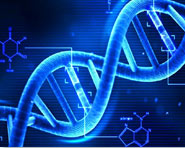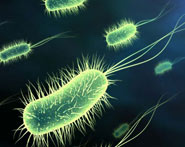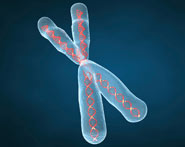


 النبات
النبات
 الحيوان
الحيوان
 الأحياء المجهرية
الأحياء المجهرية
 علم الأمراض
علم الأمراض
 التقانة الإحيائية
التقانة الإحيائية
 التقنية الحيوية المكروبية
التقنية الحيوية المكروبية
 التقنية الحياتية النانوية
التقنية الحياتية النانوية
 علم الأجنة
علم الأجنة
 الأحياء الجزيئي
الأحياء الجزيئي
 علم وظائف الأعضاء
علم وظائف الأعضاء
 الغدد
الغدد
 المضادات الحيوية
المضادات الحيوية|
Read More
Date: 19-5-2016
Date: 28-12-2015
Date: 3-12-2015
|
In the cell nucleus, large numbers of genes are attached end on end in extremely long double-stranded helical molecules of DNA having molecular weights measured in the billions. A very short segment of such a molecule is shown in Figure 1. This molecule is composed of several simple chemical compounds bound together in a regular pattern, the details of which are explained in the next few paragraphs.
Fig1. The helical, double-stranded structure of the gene. The outside strands are composed of phosphoric acid and the sugar deoxyribose. The internal molecules connecting the two strands of the helix are purine and pyrimidine bases, which determine the “code” of the gene.
Basic Building Blocks of DNA
Figure 2 shows the basic chemical compounds involved in the formation of DNA. These compounds include (1) phosphoric acid, (2) a sugar called deoxyribose, and (3) four nitrogenous bases (two purines, adenine and guanine, and two pyrimidines, thymine and cytosine). The phosphoric acid and deoxyribose form the two helical strands that are the backbone of the DNA molecule, and the nitrogenous bases lie between the two strands and connect them, as illustrated in Figure 3.
Fig2. The basic building blocks of DNA.
Fig3. Arrangement of deoxyribose nucleotides in a double strand of DNA.
Nucleotides
The first stage of DNA formation is to combine one molecule of phosphoric acid, one molecule of deoxyribose, and one of the four bases to form an acidic nucleotide. Four separate nucleotides are thus formed, one for each of the four bases: deoxyadenylic, deoxythymidylic, deoxyguanylic, and deoxycytidylic acids. Figure 4 shows the chemical structure of deoxyadenylic acid, and Figure 5 shows simple symbols for the four nucleotides that form DNA.
Fig4. Deoxyadenylic acid, one of the nucleotides that make up DNA.
Fig5. Symbols for the four nucleotides that combine to form DNA. Each nucleotide contains phosphoric acid (P), deoxyribose (D), and one of the four nucleotide bases: A, adenine; T, thymine; G, guanine; or C, cytosine.
Nucleotides Are Organized to Form Two Strands of DNA Loosely Bound to Each Other
Figure 3 shows the manner in which multiple numbers of nucleotides are bound together to form two strands of DNA. The two strands are, in turn, loosely bonded with each other by weak cross-linkages, as illustrated in Figure 3 by the central dashed lines. Note that the backbone of each DNA strand is composed of alternating phosphoric acid and deoxyribose molecules. In turn, purine and pyrimidine bases are attached to the sides of the deoxyribose molecules. Then, by means of loose hydrogen bonds (dashed lines) between the purine and pyrimidine bases, the two respective DNA strands are held together. Note the following caveats, however:
1. Each purine base adenine of one strand always bonds with a pyrimidine base thymine of the other strand.
2. Each purine base guanine always bonds with a pyrimidine base cytosine.
Thus, in Figure 3, the sequence of complementary pairs of bases is CG, CG, GC, TA, CG, TA, GC, AT, and AT. Because of the looseness of the hydrogen bonds, the two strands can pull apart with ease, and they do so many times during the course of their function in the cell.
To put the DNA of Figure 3 into its proper physical perspective, one could merely pick up the two ends and twist them into a helix. Ten pairs of nucleotides are present in each full turn of the helix in the DNA molecule, as shown in Figure 1.
GENETIC CODE
The importance of DNA lies in its ability to control the formation of proteins in the cell, which it achieves by means of a genetic code. That is, when the two strands of a DNA molecule are split apart, the purine and pyrimidine bases projecting to the side of each DNA strand are exposed, as shown by the top strand in Figure 6. It is these projecting bases that form the genetic code.
Fig6 Combination of ribose nucleotides with a strand of DNA to form a molecule of RNA that carries the genetic code from the gene to the cytoplasm. The RNA polymerase enzyme moves along the DNA strand and builds the RNA molecule.
The genetic code consists of successive “triplets” of bases—that is, each three successive bases is a code word. The successive triplets eventually control the sequence of amino acids in a protein molecule that is to be synthesized in the cell. Note in Figure 3 that the top strand of DNA, reading from left to right, has the genetic code GGC, AGA, CTT, with the triplets being separated from one another by the arrows. As we follow this genetic code through Figures 6 and 7, we see that these three respective triplets are responsible for successive placement of the three amino acids, proline, serine, and glutamic acid, in a newly formed molecule of protein.
Fig7. A portion of an RNA molecule showing three RNA codons—CCG, UCU, and GAA—that control attachment of the three amino acids, proline, serine, and glutamic acid, respectively, to the growing RNA chain.



|
|
|
|
مقاومة الأنسولين.. أعراض خفية ومضاعفات خطيرة
|
|
|
|
|
|
|
أمل جديد في علاج ألزهايمر.. اكتشاف إنزيم جديد يساهم في التدهور المعرفي ؟
|
|
|
|
|
|
|
العتبة العباسية المقدسة تقيم ندوة علمية عن روايات كتاب نهج البلاغة
|
|
|